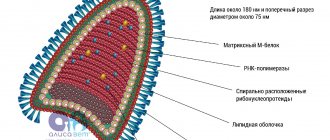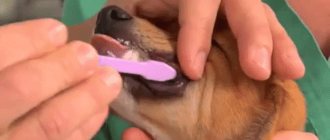The situation when a dog swallows “something wrong” is a fairly common occurrence. It’s good if it’s just a small toy, coin or other small thing - they will come out on their own without causing much discomfort to the animal. But it could also be something that poses a threat to the pet's life. For example, a toxic substance. Therefore, you need to know how to induce vomiting in a dog, because delay can cost your dog’s life. It is advisable to take any measures only within two hours after taking hazardous substances. Later, there is no point in inducing vomiting - toxins are absorbed into the blood and destroy the body, so you need to immediately contact a veterinarian.
In what situations is this needed?
The gag reflex is a natural and completely normal reaction of the pet’s body to dangerous substances. Often, a pet can vomit once, but he will feel quite well. However, sometimes he needs help to provoke such a process. Otherwise, the situation may become life-threatening for your four-legged friend.
In case of poisoning, vomiting must be induced as quickly as possible, otherwise toxic substances will enter the intestines, be absorbed into the blood and spread throughout the dog’s body, which can lead to irreparable consequences.
It is necessary to induce vomiting in a dog when it has eaten toxic substances - chemical or natural. The most common poisonings are caused by eating:
- rat poison (or the poisoned rodent itself);
- substances to combat various insects;
- substances for controlling weeds in garden beds;
- chocolate (contains substances hazardous to the cardiovascular system and digestive system);
- antifreeze (often attracts dogs with the smell);
- leaves, stems, fruits of poisonous plants (domestic and wild);
- various medications.
Usually, vomiting should be induced no later than in the first 1.5 to 2 hours after toxic substances enter the body of the affected pet.
Types of poisoning
Veterinarians divide animal poisoning into two types:
- Food. Statistics show that food poisoning accounts for the largest number of all cases. This occurs when any poison or other toxic substance enters the dog's body. For example, an animal may pick up discarded medications on the street or eat spoiled food.
- Non-food. This species is characterized by the fact that toxic substances enter the animal's esophagus through the pores, respiratory system or mucous membrane.
What you can use at home
There are both pharmaceutical and improvised means to induce vomiting in a dog. You should not use several methods at the same time; you need to choose one most suitable option and do not hesitate to provide assistance.
Water
A large volume of plain drinking water that enters the stomach leads to its elimination back out. For large breed dogs, the amount of water required to induce vomiting can be about three liters. It is often difficult to force a pet to drink so much liquid, so you often have to pour it in by force. For a better effect and a more comfortable feeling for your pet, you should warm up the water a little.
Hydrogen peroxide
It should be noted that despite the fact that some owners practice dropping undiluted peroxide into the dog’s mouth, only a 1.5% solution is suitable for oral use (pharmacies sell solutions with a concentration of 3%).
If you give your dog peroxide in its pure form, you can cause damage to the mucous membranes and thereby further harm the pet’s health.
The solution is made by mixing 1:1 clean drinking water and hydrogen peroxide. Place it on the root of the tongue so that the dog swallows the mixture. 1 teaspoon of product is calculated for approximately 5 kg of dog’s body weight. If vomiting does not occur within 5–10 minutes, the peroxide solution in the same dosage is given again.
Potassium permangantsovka
A weak solution is prepared (the color should be pale pink) and the dog is force-fed with this liquid. Depending on the size of the dog, the volume of potassium permanganate solution drunk varies - from about 0.5 liters. up to 3 liters, as in the case of plain water. Vomiting usually occurs within a very short time.
Vaseline oil
This product has an enveloping effect, so it additionally protects the gastric mucosa from damage and reduces absorption. You can also induce a gag reflex in a dog using purified petroleum jelly. You need to give your pet 100–200 ml of this substance to drink, which will provoke the necessary reaction.
Decoctions of chamomile, St. John's wort
Sometimes dogs are given decoctions of these medicinal herbs to induce vomiting. In terms of volume, the pet needs to drink 0.5 - 3 liters of liquid, depending on the size of the dog. Chamomile and St. John's wort do not have pronounced emetic properties; they are more gentle compared to many other drugs.
Hellebore tincture
Causes increased gastric peristalsis and, as a result, belching and vomiting. The product is used in a dosage of 0.05 - 2 ml for one dog, depending on its weight. The action comes quite quickly.
Salt
Simple kitchen salt can help induce vomiting. Can be used in two ways:
- Pour about 2 - 3 g of salt (half a teaspoon) onto the root of the tongue to influence the taste buds. There is no need to force your dog to swallow the powder;
- Prepare saline solution. For representatives of small and medium breeds of dogs, a less concentrated solution is used (20–30 g of salt per 500 ml of drinking water), while for large breeds the salt concentration is increased (50–60 g of salt per 500 ml of water). The liquid is given to the dog in one go.
1 teaspoon contains 5 - 7 g of salt without a slide, 10 g with a slide; in 1 tablespoon - approximately 20 g without a slide, 30 g with a slide.
Salt also reduces the absorption of various substances into the blood, thereby inhibiting the process of poisoning. However, many experts still do not recommend using salt to induce vomiting in dogs, since it itself is quite toxic for pets. In addition, if vomiting does not occur, salt has a detrimental effect on the mucous membranes of the dog’s body and can cause irritation, sometimes even ulcers.
Ipecac (emetic root)
Syrups, extracts, infusions and tinctures are made from this plant. The drugs have expectorant properties and can also cause vomiting. To provoke nausea in a pet, the dog is given vomit root syrup in a dosage of 1 teaspoon per 5 kg of live weight.
Very small dogs and puppies are allowed to swallow just a few drops. Vomiting occurs within a few minutes. At the moment, ipecac root syrup is practically no longer used as an emetic for a number of reasons: vomiting from such a remedy lasts a long time and is exhausting; if the pet does not vomit, the drug that is not excreted has a bad effect on the gastric mucosa - it causes irritation; An incorrectly calculated dose can lead to complications.
Apomorphine (apomorphine hydrochloride)
A medicine that is administered subcutaneously in a dosage of 0.002 - 0.005 g, depending on the dog’s body weight. Apomorphine acts directly on a specific area of the brain, which causes severe vomiting. After introduction into the body, the reaction occurs instantly - no later than the first couple of minutes. However, the medication should be used with caution, carefully calculating the dose, since apomorphine also affects the respiratory center. In addition, the medicine is difficult to obtain - it is sold by prescription.
Causes of intoxication
According to observations, dogs are poisoned due to the fault of their owners. Because dogs are not able to sort through food, as cats can do, they eat everything that their owner gives them. In addition, they can try what they find on the street.
But let's still establish the reasons why dogs are poisoned. So, poisoning can occur in several cases:
- Eating spoiled food. If the owner gives the dog something that should simply be thrown away. Don’t think that a dog’s stomach is so strong that it can digest everything. Missing products can have a detrimental effect on the animal’s body, even to the point of death.
- Incorrect diet of the animal. It should be understood that this is a predator, but you cannot feed it only meat, because protein poisoning will occur.
- If you allow an animal to pick something up from the ground on the street or rummage through a trash bin. So, the dog, by his actions, shows that he is not fed at home or is not given what his body requires. For example, he lacks vitamins, minerals or other nutrients.
- Do not leave medications or other toxic substances in a place where an animal can get them.
- Improper storage of animal food, which causes it to become unusable. Also, you should not buy cheap food that is produced by a dubious company.
- Be careful when treating your animal; you do not need to give it more medications than required.
- Do not allow the animal to lick fruits treated with poison against insect pests.
- You need to carefully watch the animal while walking so that the dog does not eat poisonous plants.
When is it prohibited to induce vomiting?
Sometimes, under no circumstances should you induce vomiting in dogs, so as not to aggravate the situation. These moments include:
- poisoning with gasoline, kerosene, bleach, strong alkalis and acids (repeated passage of such substances through the esophagus can severely damage it, as well as the respiratory tract);
- pregnancy;
- ingestion of hard, sharp, rough objects (moving through the digestive tract of such pieces easily injure the walls of organs);
- difficulty breathing;
- bleeding from the mouth or nose (pulmonary, stomach);
- severe weakness;
- convulsions;
- unconscious state of the dog.
In case of any poisoning, you must contact your veterinarian without delay!
You need to clearly tell him what exactly the dog swallowed, how long ago he was poisoned, what symptoms are present and how severe, what measures were taken, and also answer all the questions asked - the outcome of the treatment depends on this.
What to do after
If you managed to clear the animal’s stomach of a dangerous substance or object, then you don’t need to stop there. It is imperative to consult a veterinarian so that he can assess the animal’s condition and find out whether anything threatens its health. You should not take any adsorbents indicated for toxic poisoning before consulting a specialist. If you know exactly what poisoned your dog, then take a small amount of this substance with you as a sample.
When going to the veterinarian, take a blanket with you - after vomiting, the body temperature drops.
Expert advice
Before inducing vomiting in a dog, you need to prepare a place where it will be easier to remove the vomit. You can lay down unnecessary rags or place the dog on linoleum, tiles or similar surfaces. It is convenient to go out into the yard if possible.
Physical activity and walking help to provoke vomiting. If the dog has enough strength, you can walk your pet on a leash after giving it some kind of vomiting agent. If the dog is weak, it cannot be forced to move. The pet needs to be kept at rest by being placed on its side so that it is comfortable to breathe and to eliminate the possibility of choking on vomit. You can gently massage your dog's belly.
If there are other dogs and cats living in the house, you should also pay attention to the condition of all pets, even if only one of them shows signs of poisoning. Timely provision of assistance and adherence to the veterinarian’s advice decide the outcome of the disease and affect the recovery time.
Signs that occur with any of the poisonings
The first symptom that indicates poisoning in your dog is the animal's indifference to what is happening around it. The animal begins to refuse food and spends more time lying down. Then weakness appears, and the following symptoms appear:
- Disturbances occur in the musculoskeletal system.
- There is a disturbance in breathing.
- The mucous membrane changes its color and becomes yellow.
- Profuse diarrhea begins.
- The animal experiences a constant feeling of thirst.
- Vomiting appears, sometimes with foam.
- Salivation increases.
- The dog begins to wheeze, cough and choke.
- The dog's condition may vary; there are times when the animal simply walks in a circle.
- Involuntary emptying of the bladder occurs.
- Heart rate changes.
- An unpleasant odor emanates from the mouth.
Methods of therapy
If you cannot help your pet, then wait for the veterinarian. He will provide your dog with emergency assistance and do everything necessary to save the animal, for example:
- In case of poisoning, and the owner knows exactly what kind, the doctor will administer an antidote.
- In some cases, you will need to rinse your dog's stomach.
- He will put on an IV to cleanse the body.
- Administration of other medications.
After providing emergency assistance, drinking large amounts of fluid, using diuretics, and a special diet are prescribed.
Further actions
After you have managed to make the dog vomit, you need to give it any adsorbent, for example, activated carbon. Then give him some water, calm him down and take him to the veterinarian (or call him to your home). First aid for poisoning is very important, but in the future the animal may need systemic treatment.
Thus, by performing a few simple steps, you can achieve the desired result. The most important thing is to choose the right method for inducing vomiting in your pet so that it is as effective and safe as possible for him.











